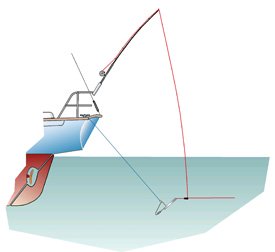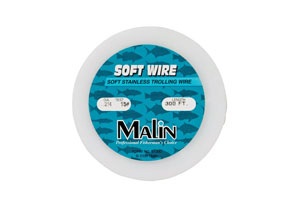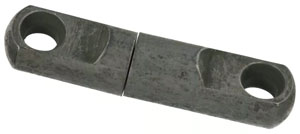- Home
- Fishing Techniques
- Wire Line Fishing
Wire Line Fishing Techniques for Special Situations
A wire line fishing outfit is what you need to deal with strong currents and boat speed without resorting to heavy lead sinkers. After all, wire line is both heavier and thinner than mono or braid line, so it will come as no surprise that it sinks faster and offers less resistance to the water flowing past it.
Before the advent of braid line, bottom fishing in deep water from an anchored boat was a serious challenge when a spring tide really got going.
In those days, the solution was a wire line fishing outfit. Mine comprised a 30lb class roller-guide boat rod, a Penn 49 Super Mariner reel with a narrow spool and 200m of 7 strand wire line.
With this outfit, a 4oz lead sinker would hold bottom, while those anglers around with standard gear couldn't get anywhere near it with a pound of lead.
Not any more though, we now prefer a braid line outfit for bottom fishing in strong tides.
But there is one situation in which a wire line fishing outfit still excels - deep trolling.
Why Not Just Use a Downrigger?
 A fixed downrigger line on the stern of a sailboat
A fixed downrigger line on the stern of a sailboatGood question! Downriggers are very effective at getting your lure down deep, but the problem arises after a hook-up.
A real risk of a tangle between the downrigger line and the trolling line exists, unless the downrigger line is cleared - no mean task, particularly if you're short-handed.
Or an In-Line Trolling Sinker or Planer?
 Trolling handline with a barrel-lead trolling weight
Trolling handline with a barrel-lead trolling weightWhilst both of these options are simple and effective - especially on a snubber line - they suffer from the drawback of having an unwieldy weight on the line during the fish-fighting process.
And with a Wire Line Fishing Set-Up?
Now there's no downrigger line to clear, no heavy sinker or planer on the line to complicate things - just a straight-through unencumbered wire line between the reel and the fish.
Trolling with wire line is best done at a low speed, enabling maximum depths to be achieved.
As a general rule, when trolling at 3 to 4 knots, each 20m of monel line deployed will get your lure down to at least 2m, so 100m will achieve a minimum trolling depth of around 10m and considerably more with a deep-diving plug like this one.
Trolling with a greater length of wire than this tends to be counterproductive, as the cumulative drag causes the line to plane back up.
Wire Line for Trolling
Wire line intended for trolling is produced in one of two materials - single-strand stainless steel or single-strand monel wire:~
- Stainless Steel Wire isn't particularly malleable. It breaks easily when kinked which makes it quite difficult to attach to other lines or hardware. On the plus side, it's cheaper than monel wire.
- Monel Wire, a nickel-copper alloy, is more pliable and kink resistant. Monel is also denser and consequently sinks more rapidly and stays deeper than stainless. Although more expensive, its better performance and reliability makes monel the favoured material of most wire line trollers.
Both stainless and monel are available in several breaking strains of between 15lb and 100lb and are normally sold in 50m spools, two of which may be connected.
I tend to let out the whole 100m of wire as this achieves the greatest depth and avoids undue wear to the guides on the rod.
But wire line is more expensive than other line types, and it does require specialised gear...
Specialised Rods & Reels for Wire Line Fishing
Don't be tempted to use your standard trolling gear with wire lines; you'll quickly ruin them if you do!
Wire Line Trolling Rods
Specialized wire line rods often have a specialized swivel tip. Standard ring line guides aren't suitable for use with wire - they'll quickly become grooved and unusable.
They must be tungsten carbide, but my preference is to use a rod with oversize 'Aftco' roller guides throughout, accepting the higher degree of maintenance that comes with a rod of this kind.
Trolling Reels for Use With Wire Line
Trolling Reels for use with wire line must similarly be chosen with care. First, avoid using a reel with an aluminium spool, as the resulting galvanic action will eventually destroy the spool.
Penn Wire Line Fishing Reels are the ones to use, but make sure specify the SP model which features a bronze spool for wire line, which prevents electrolysis between the wire line and the spool.
One of the older Penn Senator models which sport a cast chrome-over-bronze spool would also be a good choice - typically, a 6/0 loaded with 100m of 50lb monel and 300m of mono or braid backing. A Penn Senator 4/0 would be fine for up to 30lb wire, and a 9/0 for an 80lb outfit.
With the heavy outfit in particular you won't want to play the fish conventionally - the lack of stretch and the weight of the gear would be prohibitive. Leave the rod - ideally a bent-butt type - in the rod holder and simply winch the fish in whenever it's not taking line.
Making Connections
Connecting up a wire line fishing outfit is simple - you just need to know a couple of specialised knots; the Haywire Twist and the Albright Special Knot.
Use the Haywire Twist for connecting wire to a swivel, and the Albright Knot for connecting wire to mono or braid fishing line.
There's another method of making the connections in a wire trolling rig, and that's to use a swivel between the wire and the backing and another one between the wire and the leader.
You'll clearly need swivels that can pass through the rod rings or negotiate the rollers without getting hung up - 'Wind-On' Swivels with their narrow diameter and high strength are the ones to use here.
Wire Line Safety
Wire line of any kind must be used with great care, as a trip to the cheese counter at your local supermarket will demonstrate. I always use a long mono leader so that when my catch is close to the boat all the wire is safely back on the reel.
This is a particularly good idea if you're using a trolling weight attached between the wire line and the leader, necessitating handlining the fish up to the gaff.
And of course if you expecting a wahoo or other toothy character to put in an appearance, you'll need another shorter wire leader ahead of the lure.
Recent Articles
-
Sea Fishing Rods and Reels Must Be Compatible for a Balanced Outfit
Mar 08, 21 08:30 AM
A quality reel fitted to a quality rod doesn't necessarily make it a quality outfit. Your fishing rods and reels have to be properly matched if you're to get the best out of them, and here’s how -
Essential Lure Fishing Tips That All Saltwater Anglers Should Know
Mar 08, 21 04:51 AM
Which single lure fishing tip applies to trolling, jigging, baitcasting, spinning, fly fishing and any other branch of lure fishing? Well, it is the one at the top of this list -
Vital Jig Fishing Tips That You Really Cannot Afford To Miss!
Mar 07, 21 10:20 AM
Essential jig fishing tips to help you select the right lure for successful jig fishing, together with the techniques required to get the most out of your jig fishing outfit


























New! Comments
Have your say about what you've just read! Leave me a comment in the box below.